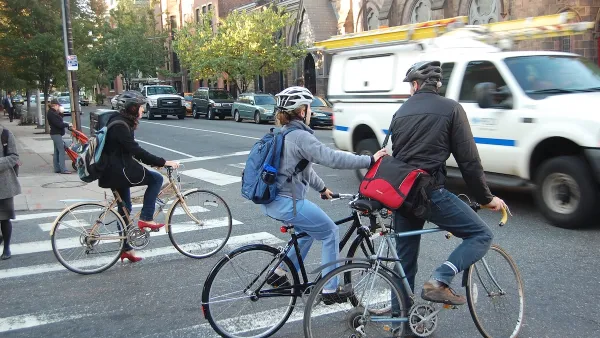The Philadelphia Inquirer's architecture critic sets out to find the outer edge of the Philadelphia suburbs, and finds a "zombie subdivision."
"Oakcrest has a network of immaculately paved streets, glossy utility boxes, and an active sales office. What it does not have is a lot of houses," writes Inga Saffron.
"Oakcrest was laid out for 169 single-family homes, but only 32 were completed when the builder went belly up after the 2007 housing crash. The result is a kind of zombie subdivision: Oakcrest is outfitted with all the necessary infrastructure, but it lacks the pulse of human life. Numbered signs resembling grave markers have been jammed into the earth to identify the available house lots."
Is this just another victim of the housing crash, Saffron wonders, or "a sign that the region's suburban sprawl has finally reached its limit?"
Saffron uses the Oakcrest example to review the debate between suburbia and increased density: " 'The word suburb has lost its meaning," acknowledges Alan Berube, a fellow at the Brookings Institution. The real competition, he suggests, is no longer between cities and suburbs, but between places that have density and good transit connections and those that don't. By that definition, North Philadelphia could be well-placed for a comeback, but the city's suburbanized Northeast may struggle. The success of Collingswood has everything to do with the proximity of PATCO trains and its small house lots... It's low-density, fringe exurbs like Oakcrest, beyond the orbital pull of the big city, that may not have much of a future."
Thanks to Architect Magazine
FULL STORY: Changing Skyline: Suburbia's outer ring losing shine, some economists say

Planetizen Federal Action Tracker
A weekly monitor of how Trump’s orders and actions are impacting planners and planning in America.

San Francisco's School District Spent $105M To Build Affordable Housing for Teachers — And That's Just the Beginning
SFUSD joins a growing list of school districts using their land holdings to address housing affordability challenges faced by their own employees.

The Tiny, Adorable $7,000 Car Turning Japan Onto EVs
The single seat Mibot charges from a regular plug as quickly as an iPad, and is about half the price of an average EV.

Even Edmonton Wants Single Staircase Buildings
Canada's second most affordable major city joins those angling to nix the requirement for two staircases in multi-family buildings.

Duffy Threatens to Cut DOT Funds to “Sanctuary Cities”
“Follow the law or forfeit the funding” says US Secretary of Transportation.

Trump Approves Futuristic Automated Texas-Mexico Cargo Corridor
The project could remove tens of thousands of commercial trucks from roadways.
Urban Design for Planners 1: Software Tools
This six-course series explores essential urban design concepts using open source software and equips planners with the tools they need to participate fully in the urban design process.
Planning for Universal Design
Learn the tools for implementing Universal Design in planning regulations.
Smith Gee Studio
City of Charlotte
City of Camden Redevelopment Agency
City of Astoria
Transportation Research & Education Center (TREC) at Portland State University
City of Camden Redevelopment Agency
Municipality of Princeton (NJ)




























